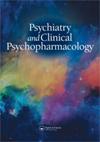精神分裂症患者情绪功能与生物节律紊乱之间的关系
IF 0.6
4区 医学
Q4 PHARMACOLOGY & PHARMACY
引用次数: 1
摘要
【摘要】目的:生物节律失调与精神分裂症患者执行功能下降和精神病加重有关,而执行功能下降和精神病加重对精神分裂症患者的心智理论(ToM)至关重要。然而,认知功能障碍、情绪信息和生物节律紊乱之间的关系仍不确定。方法:选取41例精神分裂症患者和40例年龄、性别、吸烟状况相匹配的健康对照进行研究。采用威斯康辛卡片分类测验(WCST)、Stroop测验、眼读心学测验(RMET)、神经精神病学评估生物节律访谈(BRIAN)。结果:精神分裂症患者的BRIAN总分、睡眠、活动和社交得分均高于健康对照组。BRIAN评分越高,RMET评分越低;PANSS总分、正、负得分较高,且与执行功能无关。在回归分析中,观察到性别和BRIAN评分升高与精神分裂症患者RMET评分降低独立相关。结论:这些结果提示生物节律紊乱可能与精神分裂症患者的ToM有关。未来的研究应该检查生物节律和汤姆之间的关系,以确定是否有任何因果关系可以确定。本文章由计算机程序翻译,如有差异,请以英文原文为准。
Association between emotional functioning and biological rhythm disruptions in patients with schizophrenia
ABSTRACT Objective: Dysregulation of biological rhythm is associated with reduced executive functioning and potentiating psychosis, which are essential for the Theory of Mind (ToM) among patients with schizophrenia. However, the association between cognitive dysfunction, emotional information and disruption of biological rhythm remains uncertain. Methods: Forty-one patients with schizophrenia and forty age, gender and smoking status-matched healthy controls were recruited into the study. The Wisconsin Card Sorting Test (WCST), The Stroop test, The Reading the Mind in the Eyes Test (RMET), The Biological Rhythms Interview of Assessment in Neuropsychiatry (BRIAN) were used. Results: BRIAN total, sleep, activity and social scores were higher in patients with schizophrenia than healthy controls. Higher BRIAN score was correlated with lower RMET score; with higher PANSS total, positive and negative scores, and not correlated with executive functions. In the regression analysis, it was observed that gender and increased BRIAN score was independently associated with lower scores for RMET in a patient with schizophrenia. Conclusion: These results suggest that the disruption of biological rhythm might be associated with ToM in patients with schizophrenia. Future research should examine the relationship between biological rhythm and ToM to determine if any causal associations can be identified.
求助全文
通过发布文献求助,成功后即可免费获取论文全文。
去求助
来源期刊

Psychiatry and Clinical Psychopharmacology
Medicine-Psychiatry and Mental Health
CiteScore
1.00
自引率
14.30%
发文量
0
期刊介绍:
Psychiatry and Clinical Psychopharmacology aims to reach a national and international audience and will accept submissions from authors worldwide. It gives high priority to original studies of interest to clinicians and scientists in applied and basic neurosciences and related disciplines. Psychiatry and Clinical Psychopharmacology publishes high quality research targeted to specialists, residents and scientists in psychiatry, psychology, neurology, pharmacology, molecular biology, genetics, physiology, neurochemistry, and related sciences.
 求助内容:
求助内容: 应助结果提醒方式:
应助结果提醒方式:


